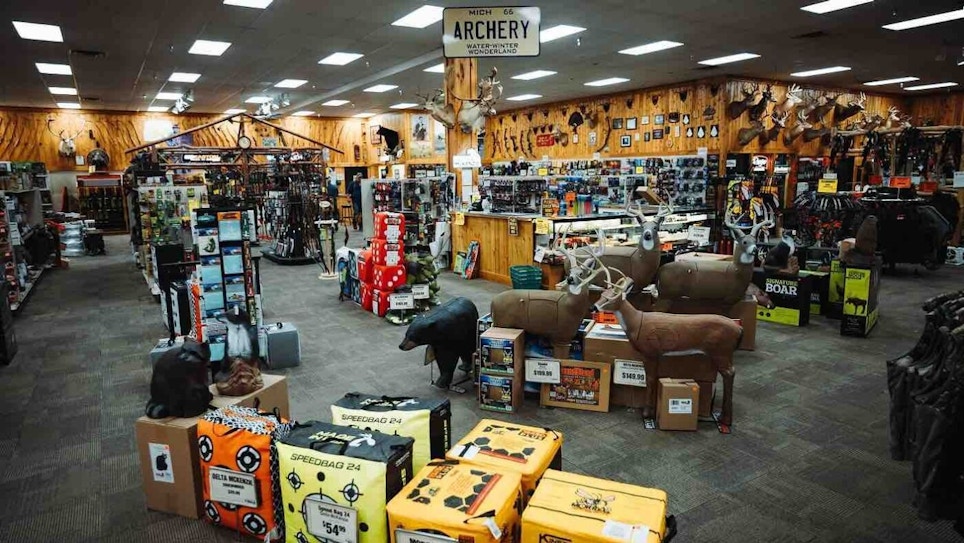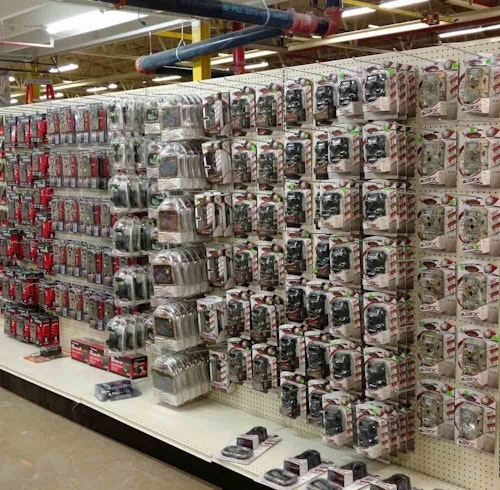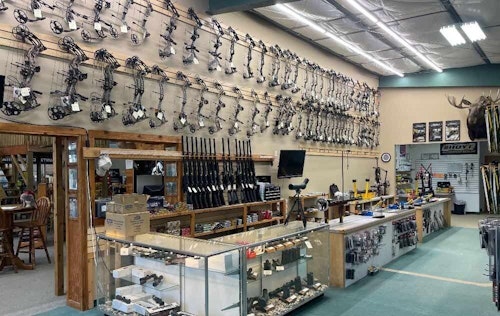
Jay’s Sporting goods in Clare is Michigan’s original outdoor superstore, including an impressive archery department in its 90,000-square-foot facility.
Today, many archery shop owners and managers make purchasing decisions at trade shows. Industry shows such as the ATA Show and SHOT Show offer attendees a myriad of benefits.
“The ATA Show brings everyone in the industry together for a once-a-year opportunity to see new products from hundreds of companies, meet product engineers and company leaders face to face, get show-special pricing and discounts, and learn ways to boost or improve their business,” explained ATA Trade Show Director Beth Berkheimer. “Attending gives you a competitive edge because you can network, gain market share, find new accounts and contacts, and gather information that helps you become a product expert.”
But like just about anything in business, there’s a right way and a wrong way to attend shows. Smart shop owners review sales data and create a flexible budget prior to attending the show, helping them make more informed buying decisions. That’s just the proverbial tip of the iceberg when it comes to making wise buying decisions. Whether you make buying decisions at a trade show or some other time, here are 10 tips to help you make the right choices for your shop.
1. Pay Attention to Trends
Understandably, pro shop owners are hesitant to make purchasing decisions based on current fads and trends. But Chris Scott, pro shop manager at Lancaster Archery in Pennsylvania (www.lancasterarchery.com) believes that keeping an open mind to what consumers are looking for is key to finding new, diamond-in-the-rough products that often sell like hotcakes.
“If you see a trend, and you’re not on it, you’re usually left behind,” Scott cautioned. “You need to keep up with trends in the industry and, within your limits for expansion, purchase new products that you haven’t carried before to increase sales and bring in new customers.”
To find the latest trends of products customers are clamoring for, Scott recommends studying the purchasing decisions of your key demographics, information you can often acquire by talking with customers and paying attention to social media chatter. It’s also important to have regular conversations with sales staff to learn what customers are requesting.
“My staff communicates this back to management, so we start to watch those products, and then determine pretty quickly if we want to bring them into our shop,” added Scott. “You also want to make a habit of regularly looking for conversations about new products online – take time to follow social media.”
Also pay attention to new products you’re hearing about at the ATA or other trade shows. Assign staff to interview sales representatives to learn about the latest gizmos unveiled that could fly off your shelves.


2. Make a Plan for the Show
Attend any industry trade show, and you can quickly become overwhelmed by the size and scope of all the different products sales reps are hawking. Before attending, study the floor plan and devise a strategy for which vendors you’ll visit each day. This helps you maximize time and keeps you focused and organized. For the ATA Show, that plan starts with attending the first day, which is reserved just for buyers, enabling you to review products, network and make buying decisions before the masses descend on the event.
“I spend the first day and a half reviewing the different products quickly, and I don’t make a lot of appointments with sales reps, where I’m tied up at one place for too long,” explained Orvie Cantrell, owner of Big O’s Archery in Sherman, Texas (903-870-2114).
One way to whittle down the number of different products you need to examine at a trade show is to evaluate some equipment prior to attending any show(s).
“We contact the sales reps and often see all the new bows before the ATA,” said Matt Poliski, owner of Grand Valley Sporting Goods in Michigan (www.gvsportinggoods.com). “This makes the ATA less daunting.”
3. Communicate and Delegate
The backbone of any successful archery store is a friendly, knowledgeable sales staff that is approachable and can provide hands-on assistance to customers. It’s imperative that owners keep a regular line of communication with all team members to garner advice on which products to buy next year, and which ones to discontinue due to recurrent problems. The information shared by sales staff greatly informs buying decisions, whether made at trade shows or at other times throughout the year.
If you don’t already, consider taking some of your sales staff with you to a trade show. Delegate which product categories each member is responsible for reviewing, recording the key features and pricing. This strategy not only frees you up to make appointments and deals with sales representatives, but also allows you to evaluate products better than you could if you tried to do it on your own. This tip works hand in hand with the need to pay attention to new sales trends. Your staff can help you identify cutting-edge equipment that you offer to customers next year.
“We send our Lancaster Archery video team to interview different sales representatives, to find out about the new and exciting products found at the ATA that might not be common knowledge,” Scott added.
4. Gather Hands-On Intel at the Trade Show
Savvy shop owners/managers recommend attending trade shows such as the ATA Show even if you don’t make many purchases at the event. There’s no substitute for getting your hands on products to evaluate not only for quality, but how well you believe they’ll sell, too.
“Often the designer of the product will be at the ATA Show, and you want to talk with them, as opposed to the sales rep, to gain valuable information that the sales rep might not know,” added Cantrell.
5. Take Advantage of Special Trade Show Deals
Manufacturers often offer promotions and special deals at different times during the show, which can translate to big savings for pro shop owners.
“When I got to the Kinsey's Dealer Show [conducted annually in Lancaster, Pennsylvania], they offer what they call Hot Show sales events, where buyers have an hour to purchase products at significant discounts,” explained Cathy Bliss, co-owner of T-Town Archery in Pennsylvania (www.facebook.com/ttownarchery). “Sometimes you have to order before you leave the room, but check with them to see if they’ll extend the deal for a brief period after the show has concluded.”
Most readers probably know that the ATA offers similar deals, but don’t wait until you get to the show to learn all about them.
“Some of the names of the promotions will change prior to the trade show, and shows will post new promotional events and deals on their websites, so check sites often,” Berkheimer added.
6. Consider Joining a Buyers’ Group
Bill Hahn, hunting buyer for Jay’s Sporting Goods in Michigan (www.jayssportinggoods.com), suggests owners consider joining a buyers’ group to expand their buying power.
“You can get better deals [belonging to a buyers’ group] than you would on your own,” Hahn said. “Some buyers’ groups offer central billing, where they pay the invoice for you, and you pay them later. This is very attractive to vendors, and they’ll often offer better deals.”
Even if you’re not sure your sales figures qualify you to join a buyers’ group, it’s worth checking to see what different companies have to offer. Many groups offer variable costs for membership based on annual purchasing volume. They also provide more than just steep discounts on product costs.
Kale Schwede, director of outdoor sports for Sports, Inc. (www.sportsinc.us) explained all his buyers’ group offers.
“We provide a means for independent archery shops to grow and prosper in a competitive marketplace. Between discounts, rebates, extended payment terms, reduced minimums and freight programs, members of Sports Inc. qualify for the best buying programs in the industry.”
Some groups such as Sports, Inc. are 100% member-owned, and they all offer annual buying shows to members who can take advantage of aggressive rebates. These discounts can help dealers achieve enhanced margins, giving them a competitive advantage over even the largest retailers in the industry. Finally, buyers’ groups like Sports, Inc. offer purchasing deals on other merchandise such as hunting accessories, camping and fishing gear, and even team/athletic apparel/equipment.
7. Manage Inventory From Start to Finish
Hahn also recommends carefully managing inventory, with a focus on doing what’s best for your company, which may mean passing on some manufacturer rebates and sales. This can be hard to do, but in the end, it will benefit your bottom line.
“For years, some archery stores would commit to all this inventory up front, put it on their shelves, but it didn’t sell for months. Even if you haven’t paid for it yet, it’s still a liability, because it’s taking up space that you could use to sell other products. Instead of doing one order, do three, so that you’re managing your inventory from start to finish throughout the entire year – that is the art of buying. Sometimes you will pay more, but you’re getting what you want when you want it, helping you better determine what’s selling and when, helping you make more informed buying decisions.”
8. Engage in Thoughtful Dating
Whether you’re buying inventory at a trade show or some other time, you’re always trying to negotiate favorable terms with suppliers. You want your dating, or buying now and paying later, to align with inventory turnover. Dating can help archery businesses get the latest equipment on their pegs without paying at the time of sales, but it can cause unforeseen problems.
“In 2008, the economy was bad, and I overbought because of dating,” explained Jim Brunette, former hunting director for Northwoods Wholesale Outlet in Michigan (www.northwoodsoutlet.com). “I got cocky because I had sold so many of a product in the prior year. I recommend taking smaller bites of products. For example, if I sold 1,000 of a specific brand of broadheads last year, I estimate that I’ll be able to sell 80% of that amount this year, so I buy less on dating. You might sell less this year because a manufacturer releases a new product midseason that you didn’t know was coming out.”

9. Be Wary of Deep Discounts
Manufacturers offer discounts on their merchandise for a variety of reasons. Special pricing can attract new customers, boost brand reputation, drive website traffic, increase brand loyalty and help companies meet sales goals. In the archery industry, companies often offer discounts to move older models of products – a tactic that Poliski strongly recommends shop owners watch out for.
“We’ve made mistakes on a bowsight or other piece of equipment that looks like it is a really good sale, but that’s because the manufacturer is going to be releasing a new model of the same product in the near future. Sales reps won’t lie to you if you ask them if they’ll be coming out with a new version of the product on sale, but sometimes they won’t offer that information up front. You have to ask if it’s last year’s model, because you don’t want to be stuck with a lot of the older ones on your shelves.”
Poliski added that this recommendation enables you to focus on buying new, high-quality products that your customers are going to want. While it might be worth it to occasionally buy an older product model for a special sales event, such as an anniversary promotion, it will be difficult to move older models, and it inadvertently sends a negative message to your customers that your shop doesn’t carry the latest archery equipment.
10. Know All Your Products
Archery shop personnel are very knowledgeable about bows and equipment that attach to them, but they often struggle understanding and explaining the myriad of technologies found in ancillary products such as odor-control apparel, trail cameras and optics. Not knowing the ins and outs of every product in your store can make you lose credibility with your customers, and can also lead you to make poor purchasing decisions.
“Don’t just listen to the sales rep of a particular product, like a game camera – go find out what the other companies are offering in their products,” Hahn recommended. “For example, with game cameras, you have to know all about them, including what data plans companies offer on their cellular models, so you can share that information with customers to help them make buying decisions.”
Let’s extend Hahn’s example by considering the different technologies cameras can contain to illuminate night photos and video. You have several customers tell you they want cameras that utilize black (no glow) flash, but you know little about it, and you’re not even sure if you sell any cameras that use black flash. Customers are tech-savvy, and they’ll quickly realize you don’t know what you’re selling. Customer confidence diminishes, and you lose out on sales of a high-end product.
Final Thoughts
Regardless of whether you buy at an industry event such as the ATA Show or SHOT Show, or at different venues and/or times, use these 10 tips to make more informed purchasing decisions. As the saying goes, knowledge is power. A knowledgeable buyer is a successful one, helping archery shops save big bucks and make big sales. Smart buying decisions will bring more customers through the door, build customer loyalty, and solidify your brand as THE go-to archery shop in the area.






